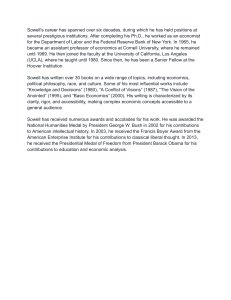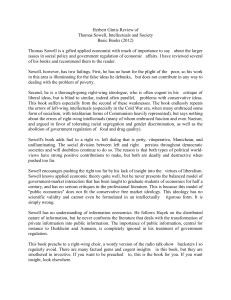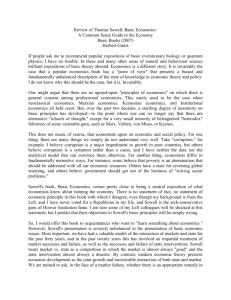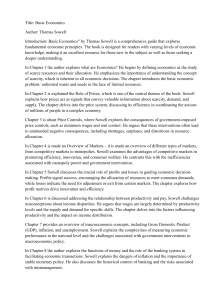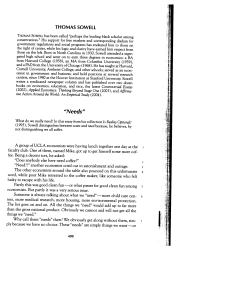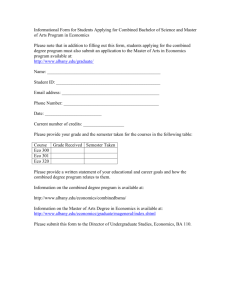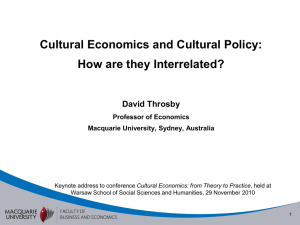course description - Wright State University
advertisement
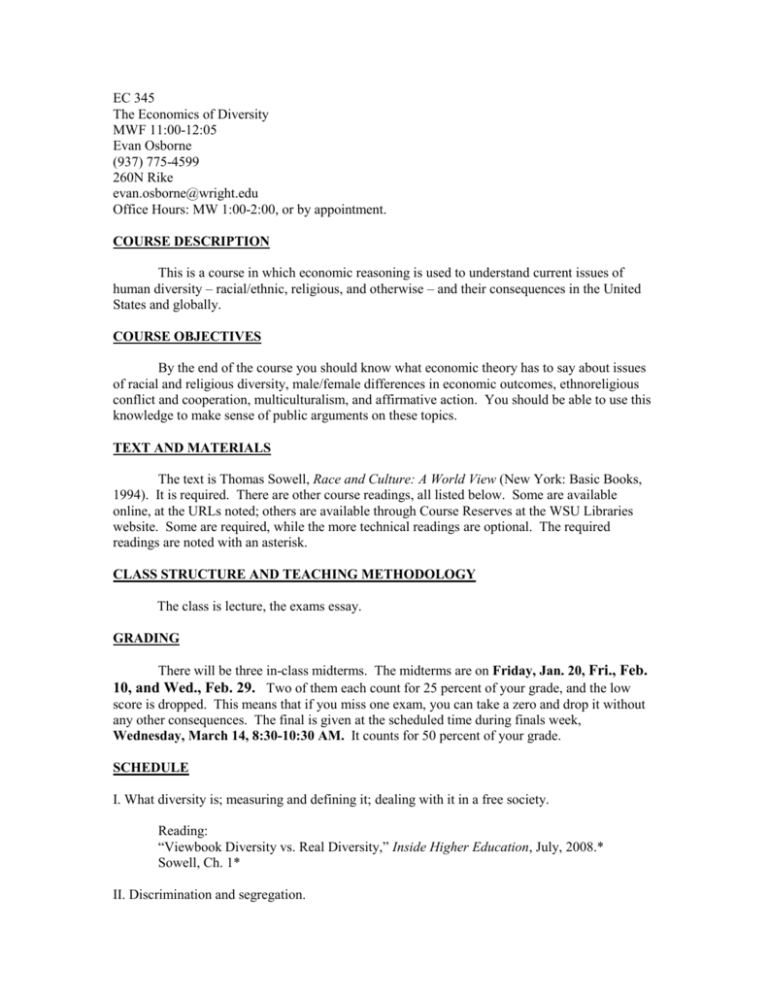
EC 345 The Economics of Diversity MWF 11:00-12:05 Evan Osborne (937) 775-4599 260N Rike evan.osborne@wright.edu Office Hours: MW 1:00-2:00, or by appointment. COURSE DESCRIPTION This is a course in which economic reasoning is used to understand current issues of human diversity – racial/ethnic, religious, and otherwise – and their consequences in the United States and globally. COURSE OBJECTIVES By the end of the course you should know what economic theory has to say about issues of racial and religious diversity, male/female differences in economic outcomes, ethnoreligious conflict and cooperation, multiculturalism, and affirmative action. You should be able to use this knowledge to make sense of public arguments on these topics. TEXT AND MATERIALS The text is Thomas Sowell, Race and Culture: A World View (New York: Basic Books, 1994). It is required. There are other course readings, all listed below. Some are available online, at the URLs noted; others are available through Course Reserves at the WSU Libraries website. Some are required, while the more technical readings are optional. The required readings are noted with an asterisk. CLASS STRUCTURE AND TEACHING METHODOLOGY The class is lecture, the exams essay. GRADING There will be three in-class midterms. The midterms are on Friday, Jan. 20, Fri., Feb. 10, and Wed., Feb. 29. Two of them each count for 25 percent of your grade, and the low score is dropped. This means that if you miss one exam, you can take a zero and drop it without any other consequences. The final is given at the scheduled time during finals week, Wednesday, March 14, 8:30-10:30 AM. It counts for 50 percent of your grade. SCHEDULE I. What diversity is; measuring and defining it; dealing with it in a free society. Reading: “Viewbook Diversity vs. Real Diversity,” Inside Higher Education, July, 2008.* Sowell, Ch. 1* II. Discrimination and segregation. A. The human-capital model of employee compensation. B. The Gary Becker model of taste-based discrimination. C. Information-based or statistical discrimination Reading: Sowell, Ch. 1, and pp. 84-92* “Applying to College: Will Chinese Applicants Be Damaged by the ‘Tiger Mom’ Stereotype?", World Journal, August 12, 2011 (translated from Chinese) "Rent a Grandma," The Fiscal Times, September 24, 2011. Megan McArdle, "FICO Frenzy," The Atlantic, July 26, 2010. D. Skills tests, the Supreme Court, and why college is now so essential. Megan McArdle, "Why Do Employers Use Pico Scores," The Atlantic, July 29, 2010. E. Can cultures be defensibly stereotyped? Reading: Sowell, pp. 10-28, 82-92* F. Affirmative action and its effects. 1. Affirmative action around the world. 2. Its effects. Readings: Roland G. Fryer Jr. and Glenn C. Loury, "Affirmative Action and Its Mythology," Journal of Economic Perspectives, 19 (3), Summer 2005.* Thomas J. Espenshade and Chang Y. Chung, “The Opportunity Cost of Admissions Preferences at Elite Universities,” Social Science Quarterly 86 (2), June 2005. Agence France Presse, “Court Rules Chinese South Africans Can Now Be Called Black,” June 18, 2008.* Russell Nieli, "How Diversity Punishes Asians, Poor Whites, and Lots of Others," Minding the Campus, July 12, 2010.* Terry Pell, “By No Means: Michigan Judge Turns Tables on Advocacy Groups Determined to Derail Civil Rights Initiative,” http://www.nas.org/polArticles.cfm?doc_id=124.* "Loss of Young Talent Towards Malaysia's Growth," The New York Times, October 1, 2010.* "Anonymous CVs Don't Work," The Connection, April 6, 2011. 3. What is the law in the U.S. regarding affirmative action? What should it be? Reading: Paul Moreno, “Affirmative Action’s Strange Career,” The Wall Street Journal, Sept. 3, 2007.* G. Competition and ethnic peace; collective bargaining and discrimination. H. Residential segregation and what to do about it. Thomas C. Schelling, “Dynamic Models of Segregation,” Journal of Mathematical Sociology 1 (1), January 1971. Rob Gurwitt, “Atlanta and the Urban Future,” Governing, July 2008.* Sowell, pp. 103-108* I. The middleman minority. Sowell, pp. 46-59* III. Conflict and cooperation. A. The theoretical model – to trade or to fight? Reading: Jack Hirshleifer, “The Paradox of Power,” Economics and Politics 3 (3), November 1991. B. Politics and markets as ways to promote cooperation. 1. The economics of open markets and intertribal cooperation. Readings: BBC, “India 2026: What Will Life Be Like?”, http://news.bbc.co.uk/2/hi/business/4773425.stm.* “Young and Arab in a Land of Mosques and Bars,” The New York Times, Sept. 22, 2008.* Sowell, Chs. 4-5* 2. Group differences and politics Reading: Sowell pp. 93-100, Ch. 5* IV. The economics of identity. A. Identity as a portfolio; exclusivist and inclusivist identities; identity subsidy. Readings: “Journey From a Chinese Orphanage to a Jewish Rite of Passage,” The New York Times, March 8, 2007.* “Latinos or Hispanics? A Debate About Identity,” The Washington Post, August 25, 2003.* Evan Osborne, “How Richard Nixon Invented Hispanics,” http://futureuncertain.blogspot.com/2005/09/how-richard-nixon-invented-hispanics.html* Chapters 1 and 2 in Amartya Sen, Identity and Violence: The Illusion of Destiny (New York: W.W. Norton, 2006)* B. The economics of “acting white.” C. Multiculturalism as an identity subsidy. Readings: Osborne, Evan. “Diversity, Multiculturalism and Ethnic Conflict,” Kyklos 53 (4), 2000.* Dalrymple, Theodore. “An Imaginary Scandal,” The New Criterion 23 (9), May 2005, http://www.newcriterion.com/articles.cfm/an-imaginary-scandal-1342 “In China, Learning to the Government’s Tune," Chronicle of Higher Education, September 19, 2010. V. The economics of religion. A. The economics of religion as an individual activity. B. Religion and happiness. C. Religion and economic development. Reading: Robert J. Barro and Rachel M. McCleary, “Religion and Economic Growth Across Countries,” American Sociological Review 68 (5), October 2003. D. The economics of religion as an industry; the economics of church and state. VI. Globalization and diversity A. Global migration. Reading: Sowell, Chapter 2* Theodore Dalrymple, “The Barbarians at the Gates of Paris,” http://www.cityjournal.org/html/12_4_the_barbarians.html.* B. Globalization and cultural diversity; the culture of exchange. Nick Gillespie, “Really Creative Destruction: Economist Tyler Cowen argues for the cultural benefits of globalization,” Reason, Aug./Sept. 2003* Mario Vargas Llosa, “The Culture of Liberty,” Foreign Policy, 122, January/February 2001.* V.S. Naipaul, “The Universal Civilization,” lecture, The Independent Institute, http://www.manhattan-institute.org/html/wl1990.htm.*
